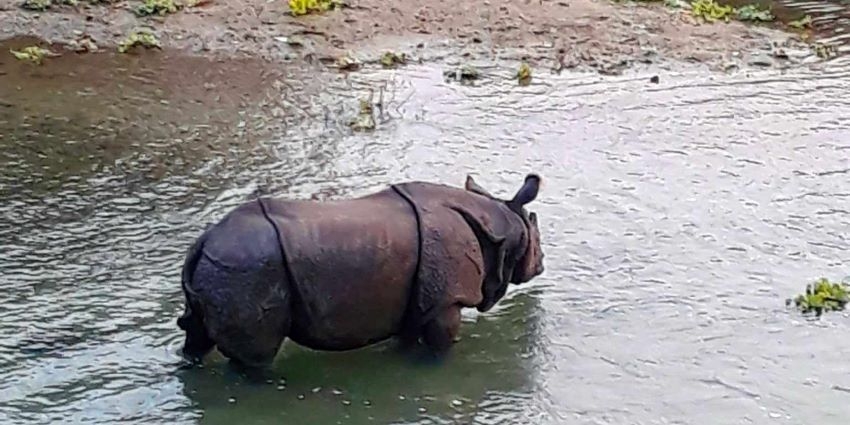
Chitwan National Park is a natural UNESCO World Heritage Site (1984), the first national park of Nepal and the formal Royal Hunting Reserve established in 1973. It covers 932 sq km of land (93,200 hectares) in the Chitwan, Nawalparasi, Parsa, and Makanpur districts ranging from 110 to 850 metres. The park is bordered by Narayani, Rapti River (north), Reu River, India (south), Sumeswar, Churia Hills, Dawney Hills (west), and Parsa National Park to the east located 165 km southwest of Kathmandu.
Chitwan National Park covers 70 % Sal (Shorea robusta) forest, 10 % riverine forest and 20% open grasslands. The park found 50 different types of grasses with 8 meters tall elephant grass (Saccharum spp.), Chir pine, Pinus Roxburgh, Khair (Acacia catechu), Sissoo (Dalbergia sissoo), Simal (Bombax ceiba) tree: the forest's flame, Palash, is a silk-cotton tree with crimson flowers that bloom in spring.
Chitwan translates to the leopard's forest (forest of Chituwa). From the beginning, the Rapti River to Mahabharat's foothills (175 sq km), the Tikauli forest was designated Mahendra Mriga Kunga in 1959. The south of Rapti River built the Rhinoceros Sanctuary in 1963. The park buffer zone established in 1996, covers 750 sq km of land, including 62 community-managed forests, such as Baghmara, Kumros, Chitrasen, Tribeni, Malika and Tinchuli. The must-visit park is rich in ecosystem diversity, such as Churia hills, ox-bow lakes and the plain of Rapti, Reu and Narayani rivers. The formal Royal Chitwan National Park changed its name to Chitwan National Park in 2006.
Chitwan National Park is the home of various flora and fauna, 600 types of plants, and 68 mammals, such as elephant, one-horned rhinoceros (694 numbers), Royal Bengal tiger (93), Arna (9), common langur, rhesus monkey, deer, leopards, sloth bear, white stocking gaur (368), wild boar, wild dogs, wild cats, and four-horned antelope. Beeshazari Tal (7.2 km south of Bharatpur) and associated lakes enlisted on the Ramsar site in August 2003. The six tourist resorts, Tiger Tops Jungle Lodge (1972), Safari Narayani, Temple Tiger, Chitwan Jungle Lodge, Machan Wildlife, and Island Jungle Resort built in the park, which was closed in 2012.
The park also documented 126 species of fish and 544 types of birds (22 globally threatened), including peacocks, woodpeckers, floricans, white storks, black storks, and red-headed trogons. The migrant birds, paradise flycatcher, Indian Pitta, parakeets, waterfowl, pintails and Brahminy ducks come from Siberia. It recorded 49 amphibians and reptiles, Gangetic crocodiles, marsh mugger crocodiles, Gangetic dolphins, snakes, pythons, several turtles and countless butterfly types.
Local people cut thatch grasses in late January as the best time to watch wildlife. The migratory birds visit the park from September to November and February to April. Chitwan Wildlife Park offers thrilling activities, Elephant safari, Jeep safari, elephant bath, canoe ride, jungle walk, bird watching, village walk and Tharu cultural show. Tharu and hill migrants live near the park.
Chitwan National Park built Machan (view tower) to observe wildlife. Tourist-standard lodges, cottages and resorts are available outside the park. The Park Headquarters Kasara has a crocodile breeding centre and museum. The Khorsor has an elephant breeding centre. The Himalayas, sunrise, and sunset view will be remarkable on a clear day. October to March is the best time to visit the park. There are 275 licensed nature guides.
Grasslands
Grasslands and waterholes occupied 20% in 1970, now only 5% enables wildlife management. Ageratina Adenophora (forest killer) damaged grasslands and other ecosystems. Saccharum spontaneum (Kans grass) is an ecosystem of habitat for wild herbivores, rhinoceros, deer and elephant fodder.
The grasslands found in Khagendramalli, Chappachuli, Amrite, Padampur, Dumaria, Jarneli, Sukebhar, Bhimle, Budhirapti, Buddha Nagar, Kachuwani, Ghatgain, Lamital, Devital and Khoria Mohan. February and March take Cutting and uprooting unwanted species and removing invading trees from the grassland.
Park Headquarter
Kasara is the park headquarters. The eastern sector is Sauraha, and the western is Amaltari. Nepal Army installed 50 security posts for park protection with 16 park staff and 13 Nepal army.
Climate
From October to February, the temperature remains at 25° Celsius, and from March to June, the temperature stays as high as 40° Celsius. Annual rainfall has recorded 2150 mm.
How to Get The Park
Fight from Kathmandu and Pokhara connects Bharatpur (20 minutes). Afterwards, a forty-minute drive (20 km) takes to the park. Daily tourist buses and private vehicles from Kathmandu (165 km) and Pokhara (150 km) get to the park.
Entry Points
1. Sauraha via Tandi Bazar
2. Bhimle via Meghauli
3. Kasara via Jagatpur
4. Khagendramalli via Bhandara
5. Ghatgain via Patihani
6. Laukhani via Pragatinagar
7. Amaltari via Danda
8. Sunachuri via Sunachuri
Entrance Fees
1. 2000 Rupee (Foreigners), 1000 Rupee (SAARC Nationals), and 150 Rupee (Nepali people).
2. Elephant Breeding Camp - 50 Rupees (Foreigners and SAARC Nationals) and 10 Rupees (Nepali people)
Park Regulations
1. Rubbish must be packed, buried, and disposed of in the designated areas.
2. Carry out non-biodegradable items such as plastic bags and bottles.
3. Use established toilets, campsites and rubbish bins en route.
4. No one should walk in the park between sunset and sunrise.
5. Flora and fauna are fully protected and must not be disturbed.
6. Do not purchase animal and plant products, which is illegal.
7. Respect religious and cultural sites
Park Headquarters Kasara Contacts
Phone No: 057521932, 057529405

